Picture this: you’ve been living with your dental implant for six months, expecting to feel completely normal by now, but you’re still experiencing discomfort. You’re not alone—while most patients enjoy pain-free implants by this point, some continue to face challenges that need attention. Understanding what’s normal versus what requires immediate care can make all the difference in your journey to a confident, comfortable smile.
Most dental implants heal beautifully within 3-6 months, but dental implant pain after 6 months isn’t always a cause for panic. Sometimes it’s your body’s way of telling you something needs adjustment, and with the right approach, you can get back on track to enjoying your life-changing results.
Key Takeaways
- Persistent pain after 6 months isn’t normal and typically indicates an underlying issue that needs professional attention
- Common causes include infection, implant failure, or bite problems that can often be successfully treated when caught early
- Immediate dental consultation is crucial for proper diagnosis and treatment planning
- Most long-term pain issues can be resolved with appropriate intervention and follow-up care
- Prevention through proper oral hygiene and regular checkups significantly reduces the risk of complications
Understanding Normal Healing vs. Concerning Symptoms
What’s Normal at 6 Months Post-Implant
By the six-month mark, your dental implant should feel like a natural part of your mouth. Here’s what you should typically experience:
✅ No pain or discomfort during normal activities ✅ Comfortable chewing on the implant side ✅ No swelling or redness around the implant site ✅ Stable implant that doesn’t move or shift ✅ Healthy gum tissue that’s pink and firm
Red Flags: When Pain Signals a Problem
If you’re experiencing any of these symptoms after 6 months, it’s time to contact your dental professional:
🚨 Persistent throbbing or sharp pain 🚨 Swelling that won’t subside 🚨 Bleeding around the implant 🚨 Loose or mobile implant 🚨 Pus or unusual discharge 🚨 Difficulty chewing or biting 🚨 Persistent bad taste or odor
Common Causes of Dental Implant Pain After 6 Months
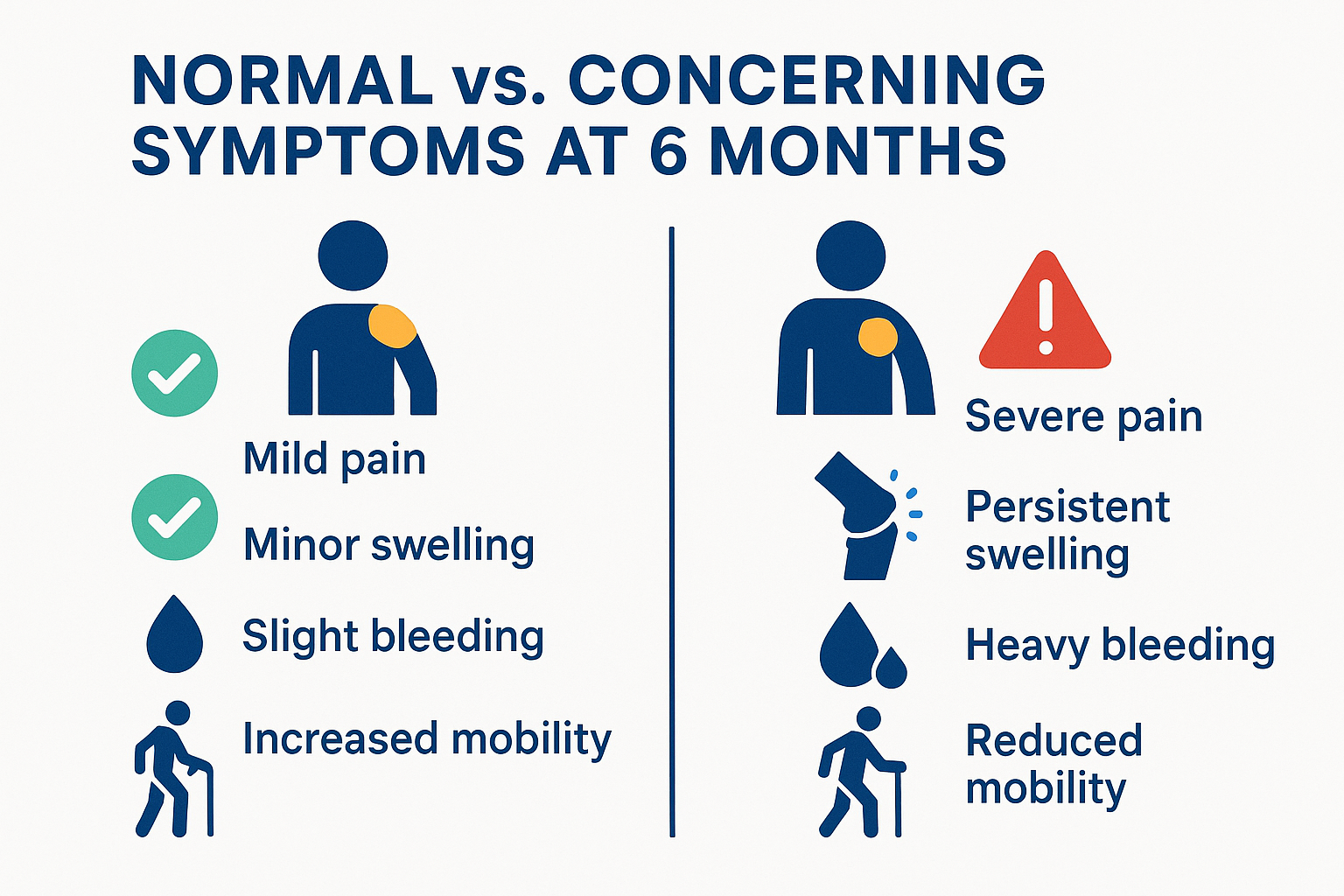
1. Peri-Implantitis (Implant Infection)
Peri-implantitis is essentially gum disease around your implant. It’s one of the most common causes of long-term implant discomfort and can develop months or even years after placement.
Symptoms include:
- Persistent pain and tenderness
- Red, swollen gums around the implant
- Bleeding when brushing or flossing
- Bad breath or metallic taste
- Visible bone loss on X-rays
Treatment options:
- Professional deep cleaning around the implant
- Antibiotic therapy
- Laser therapy to remove infected tissue
- In severe cases, surgical intervention
2. Implant Failure or Rejection
While rare (occurring in less than 5% of cases), implant failure can happen months after placement. Your body might not have fully accepted the implant, or the osseointegration process may not have completed successfully.
Signs of implant failure:
- Implant feels loose or moves
- Severe pain that doesn’t respond to pain medication
- Implant becomes visible through the gum
- Persistent infection despite treatment
3. Bite Problems and Occlusal Issues
Sometimes the crown or restoration on your implant isn’t properly aligned with your bite, creating excessive pressure and resulting pain.
Indicators of bite problems:
- Pain when chewing or clenching
- Headaches or jaw pain
- Sensitivity to pressure
- Uneven wear on surrounding teeth
4. Nerve Damage
Though uncommon, nerve damage during implant placement can cause ongoing pain, numbness, or tingling sensations.
Nerve damage symptoms:
- Persistent numbness or tingling
- Sharp, shooting pains
- Altered sensation in the lip, chin, or tongue
- Difficulty speaking or eating
🦷 Dental Implant Pain Assessment Tool
Answer these questions to understand your symptoms better
Diagnostic Approaches for Persistent Pain
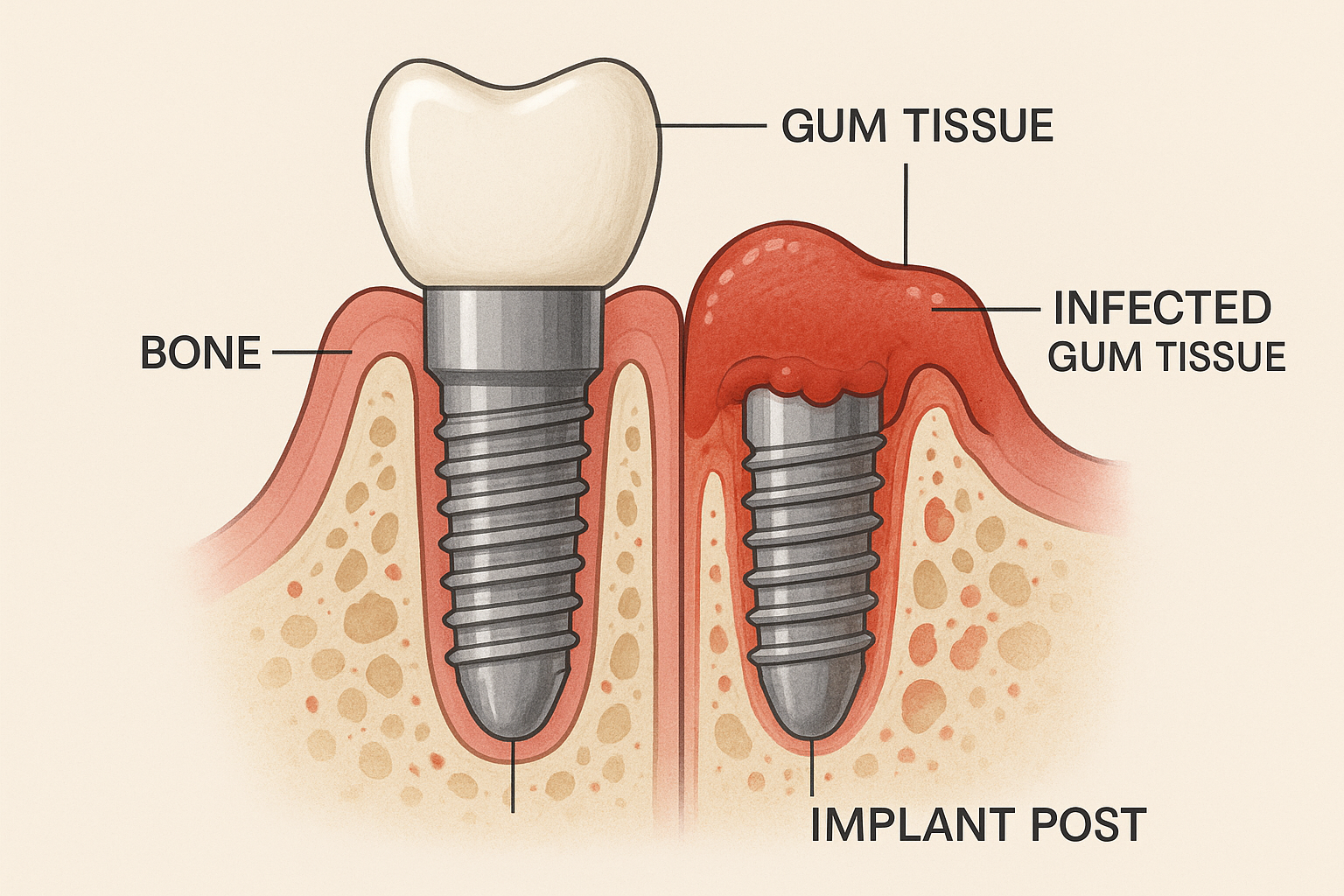
Clinical Examination
Your dentist will perform a comprehensive evaluation including:
- Visual inspection of the implant site and surrounding tissues
- Probing depths around the implant to check for pockets
- Mobility testing to assess implant stability
- Bite analysis to identify occlusal problems
Advanced Imaging
Modern diagnostic tools help identify issues not visible during clinical examination:
- Digital X-rays to check bone levels and implant position
- 3D CBCT scans for detailed bone and tissue analysis
- Intraoral photography to document tissue changes over time
Laboratory Tests
In cases of suspected infection, your dentist might recommend:
- Bacterial cultures to identify specific pathogens
- Antibiotic sensitivity testing for targeted treatment
- Inflammatory markers to assess tissue health
Treatment Options for Dental Implant Pain After 6 Months
Non-Surgical Treatments
Professional Cleaning and Debridement
- Specialized instruments remove plaque and bacteria
- Ultrasonic scaling around the implant
- Antimicrobial rinses to reduce bacterial load
Antibiotic Therapy
- Systemic antibiotics for widespread infection
- Local antibiotic placement for targeted treatment
- Anti-inflammatory medications for pain management
Bite Adjustment
- Crown reshaping to eliminate high spots
- Occlusal guard for nighttime protection
- Orthodontic adjustment if needed
Surgical Interventions
When non-surgical treatments aren't sufficient, surgical options include:
Implant Debridement Surgery
- Direct access to clean infected areas
- Removal of granulation tissue
- Surface decontamination procedures
Bone Grafting
- Regeneration of lost bone around the implant
- Guided tissue regeneration techniques
- Membrane placement for optimal healing
Implant Replacement
- Removal of failed implant
- Site preparation and healing period
- New implant placement with enhanced protocols
Prevention Strategies: Protecting Your Investment
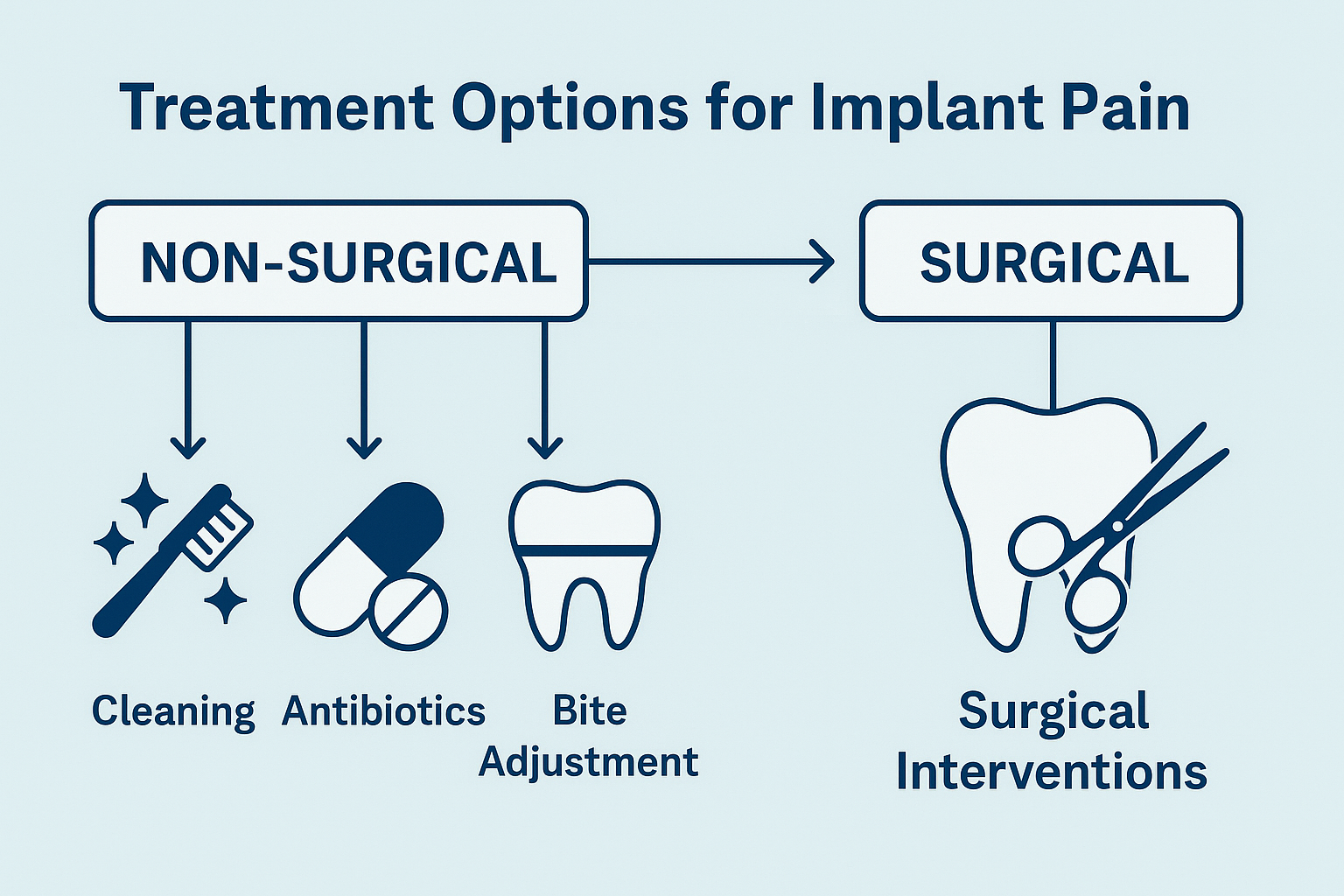
Optimal Oral Hygiene for Implants
Proper care is crucial for long-term implant success. Here's your daily routine:
Morning Routine:
- Gentle brushing with a soft-bristled toothbrush
- Flossing around implants with specialized floss
- Antimicrobial mouth rinse
Evening Routine:
- Thorough brushing for 2 minutes
- Interdental cleaning with water flossers
- Fluoride rinse for added protection
Learn more about comprehensive implant cleaning techniques to maintain optimal oral health.
Lifestyle Modifications
Avoid Harmful Habits:
- Smoking significantly increases implant failure risk
- Excessive alcohol consumption impairs healing
- Teeth grinding can damage implants and crowns
- Using teeth as tools puts unnecessary stress on implants
Understanding the risks of smoking after dental implants can help you make informed decisions about your oral health.
Regular Professional Maintenance
Recommended Schedule:
- 3-month cleanings for the first year
- 6-month maintenance visits thereafter
- Annual comprehensive exams with X-rays
- Immediate attention for any concerning symptoms
When to Seek Immediate Care
Don't wait if you experience any of these emergency symptoms:
🚨 Severe, sudden pain that doesn't respond to medication 🚨 Facial swelling that affects your ability to open your mouth 🚨 Fever accompanying implant pain 🚨 Difficulty swallowing or breathing 🚨 Implant crown falls out or becomes loose 🚨 Persistent bleeding that won't stop with pressure
Understanding signs of dental implant failure can help you recognize when immediate intervention is necessary.
Recovery and Long-Term Outlook
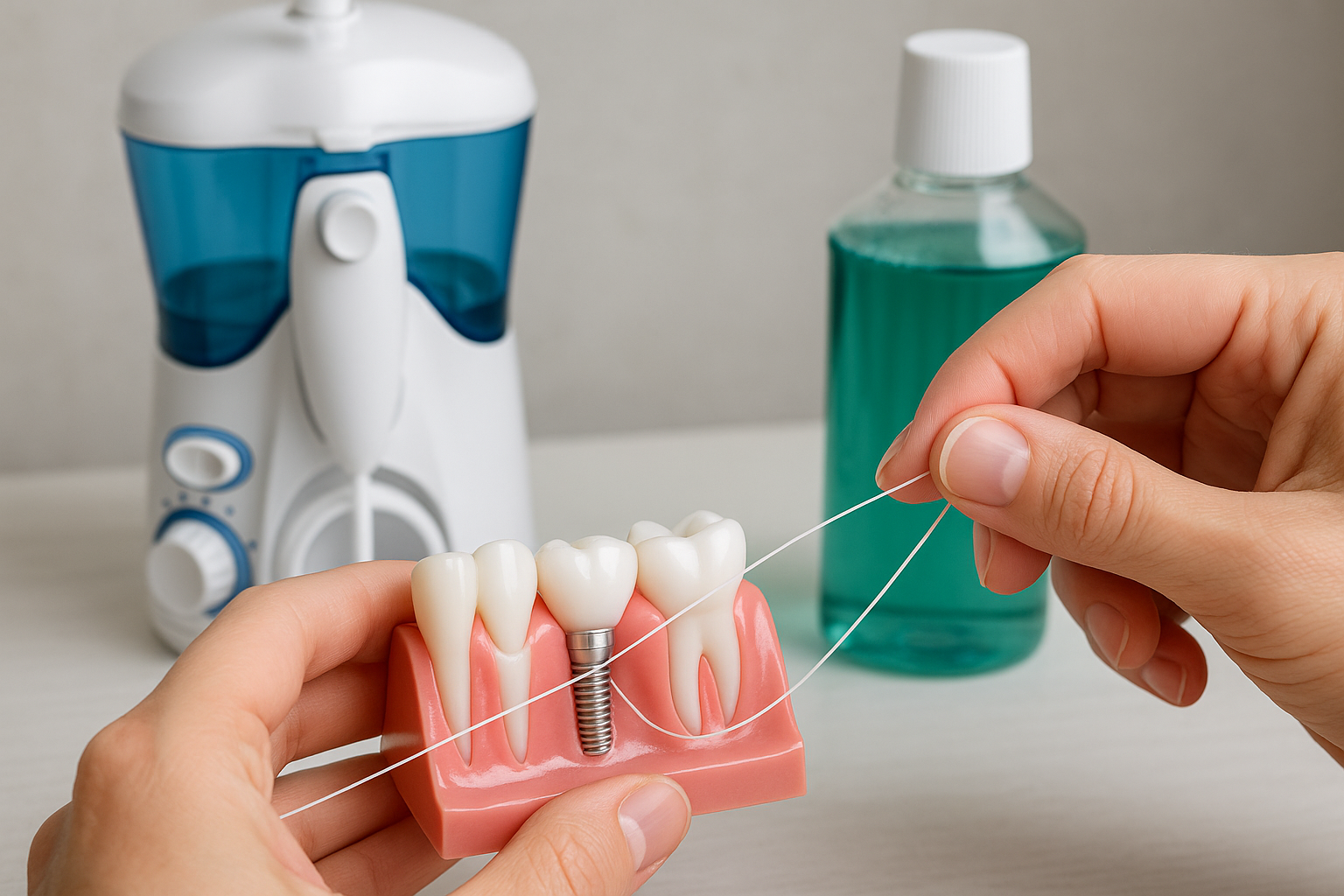
What to Expect During Treatment
Timeline for Improvement:
- Week 1-2: Initial symptom relief with proper treatment
- Month 1: Significant improvement in pain and inflammation
- Months 2-3: Complete healing and return to normal function
- Ongoing: Regular monitoring to prevent recurrence
Success Rates and Prognosis
The good news is that most implant complications can be successfully treated when caught early:
- Peri-implantitis treatment success rate: 85-90%
- Bite adjustment typically provides immediate relief
- Implant replacement success rate: 95%+ with proper protocols
Your journey back to comfort and confidence is achievable with the right treatment approach and professional guidance.
Cost Considerations and Insurance Coverage
Treatment Costs in Dallas
Understanding potential costs helps you prepare for treatment:
| Treatment Type | Estimated Cost Range |
|---|---|
| Professional cleaning/debridement | $200-$500 |
| Antibiotic therapy | $50-$200 |
| Surgical debridement | $800-$1,500 |
| Bone grafting procedures | $500-$2,000 |
| Implant replacement | $3,000-$5,000 |
Insurance and Payment Options
Many dental practices offer:
- Flexible payment plans to spread costs over time
- Insurance coordination to maximize your benefits
- Care financing options with low or no interest
- Treatment prioritization to address urgent needs first
Expert Care in Dallas: Your Path Forward
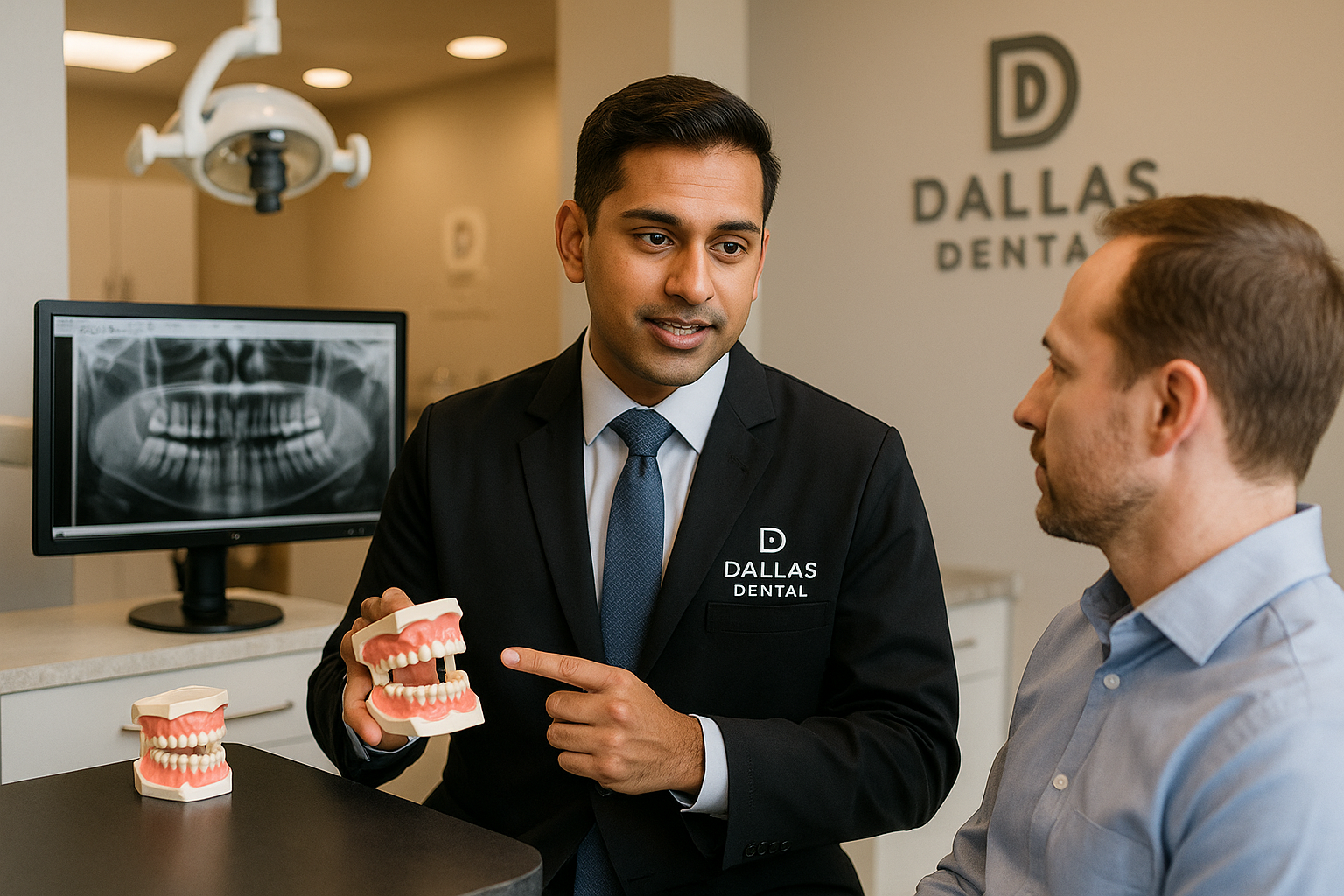
If you're experiencing dental implant pain after 6 months, you don't have to suffer in silence. Dallas offers world-class dental professionals who specialize in implant care and can help restore your comfort and confidence.
The key is taking action promptly. Early intervention not only relieves your discomfort but also protects your investment in your smile. Remember, your dental implant recovery is a journey, and sometimes that journey requires professional guidance to get back on track.
Conclusion
Dental implant pain after 6 months isn't something you should ignore or simply endure. While it's not always a sign of serious complications, persistent discomfort deserves professional attention to ensure the long-term success of your implant.
Your next steps are clear:
- Document your symptoms using tools like our assessment guide above
- Schedule a consultation with an experienced implant dentist
- Follow through with recommended treatment to address underlying issues
- Maintain excellent oral hygiene to prevent future complications
- Stay committed to regular checkups for ongoing implant health
Remember, dental implants are designed to last a lifetime with proper care. When issues arise, addressing them promptly with expert care can get you back to enjoying the life-changing benefits of a complete, confident smile.
Your journey to optimal oral health doesn't end with implant placement—it's an ongoing partnership between you and your dental team. With the right approach, you can overcome current challenges and look forward to years of comfortable, confident smiling.
Ready to take the next step? Contact our Dallas dental implant specialists today to schedule your consultation and get back on the path to comfort and confidence.


Leave a Reply
Share your thoughts or ask a question about dental implants. Your email address will not be published.